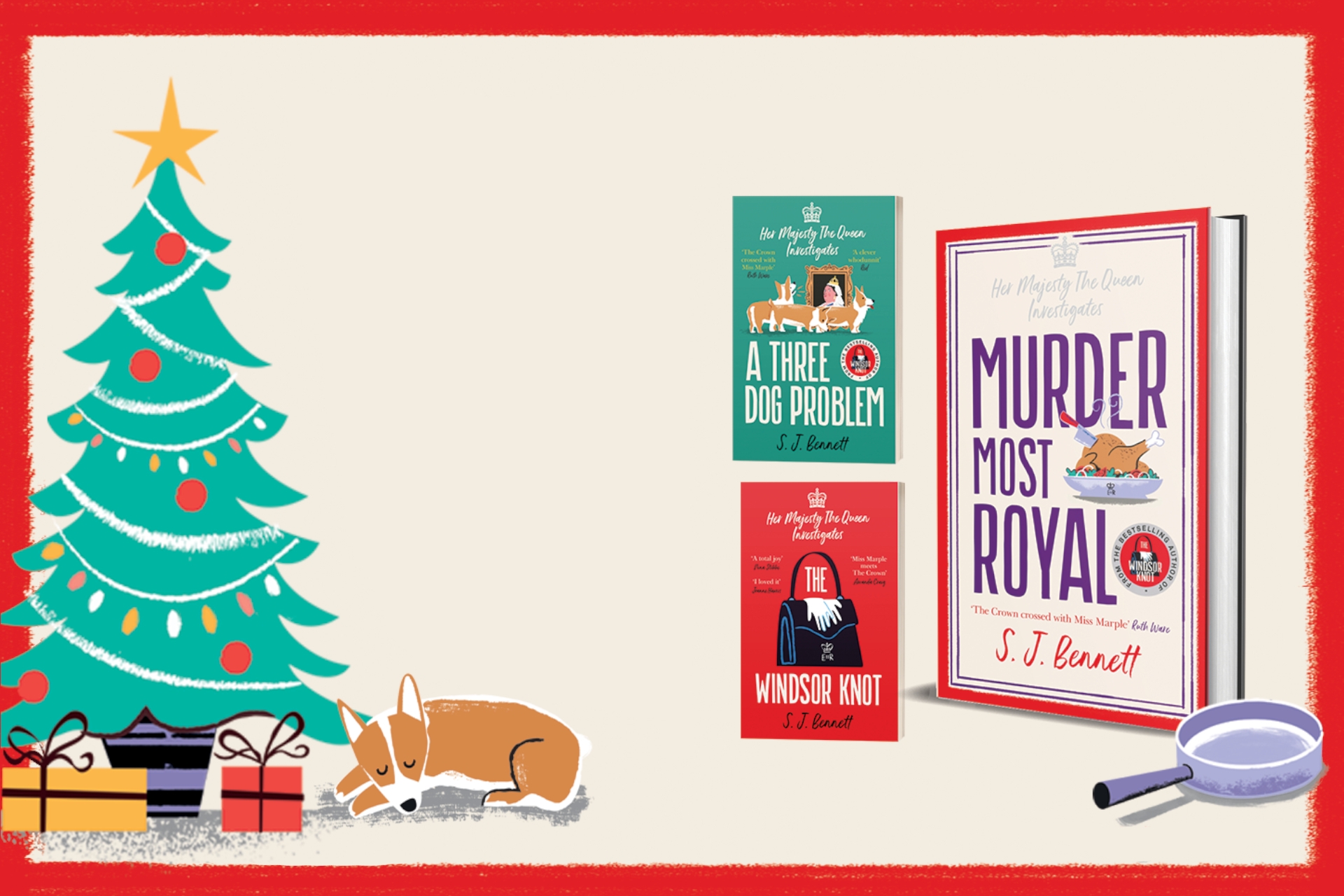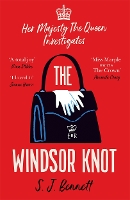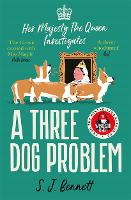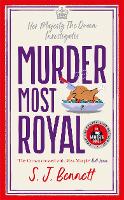Our Series of the Month is Her Majesty, The Queen, Investigates by SJ Bennett. The series captured our hearts in 2021 when we discovered the second book in the series, A Three Dog Problem. Since then, we have returned to where it all began with The Windsor Knot and adored the festive season investigation in the recently released Murder Most Royal.
All three of these books sit in our Star Books category and, in the words of Liz Robinson, "This latest book is published after the Queen’s death, and it feels like a tribute to her, all three books honour her particular qualities and abilities and there is a comforting warmth throughout. Containing the most beautiful balance between fact and fiction S.J. Bennett ensures that you think these incredible antics could in fact be real."
We were thrilled to have the opportunity to ask Sophia about this wonderful series and her writing process as well as find out about the next royal engagement. So without further ado...
How long had stories about the Queen and crime been percolating in your mind?
I first had the idea in 2018 and by that evening the Queen was already vivid in my mind as an investigator, with a keen eye for anything out of place in her world access to any expert she wanted to help her solve problems. Then I thought about the settings, from the palaces to the royal yacht and the world tours, and by nightfall I’d thought of the overall series arc and the settings for the first four books. But it took me months to find the voice, and to come up with a female sidekick that I really liked.
In the meantime, I was diagnosed with a small breast cancer, operated on, and treated with radiotherapy. I was very very lucky that we found it early. Once the radiotherapy was over in the spring of 2019, I wrote a scene between the Queen and Prince Philip that gave me the voice for The Windsor Knot, with two fairly unshockable elderly people conversing with each other about a murder. It felt somehow authentic and funny, with something true to say about the affectionate, occasionally exasperated relationship between them. After that I found the character of Rozie and wrote most of the book pretty quickly. (Apart from the denouement scene, which took a month!)
Did you ever consider an entirely fictional plot and characters or did it always have to be a blend of fact and fiction?
The blend of fact and fiction was something I was always very confident about. I knew that the Queen and the senior royals would be real, and that some real celebrities would have minor walk-on roles, but that all the staff and the people directly involved in the murder plot would be fictional. Nevertheless, their characteristics and experience were based on what I knew, or thought to be as accurate as possible. One of the fictional parts was how many people I left out! It took a village, as they say, or more like a small town, to manage the Queen’s private office and household.
Something that developed during the writing was the accuracy of the Queen’s diary. I’d originally intended to set The Windsor Knot in the vague ‘recent past’, but it became increasingly interesting to talk about her ninetieth birthday celebrations, which captured a lot of her spirit and character and popularity. Then I discovered that the Court Circular announcement of her public engagements was available online and I could, if I wanted, fit the story around what she was really doing every day. It became a game I played with myself. I had quite a detailed spreadsheet by the end charting real and fictional activity. Even the weather is right!
How difficult is it to balance the darkness of crime with a light touch?
That was what I struggled with at first. When I found myself writing the conversations between the Queen and Prince Philip, the element of comedy came naturally. The crime is undoubtedly dark, but there is something unexpected and humorous about the way the Queen – a product of her wartime generation – is unphased by it, whereas all her courtiers assume she will practically need smelling salts.
I found that writing a story based in Windsor Castle had a natural sense of safety and comfort about it. After all, it’s been a safe place for over a thousand years. That, and the Queen’s natural warmth with those close to her, and her love of animals, made it easy to keep the light touch going. It was what I needed, personally, and it turns out it’s what a lot of readers find comforting too. For which I’m very grateful.
Why did you choose to begin the series when the Queen was nearly 90?
Sheer laziness! I didn’t want to have to do too much historical research. Although in the end I discovered that even researching 2016 to get all the details right took quite a lot of work, and also that I enjoyed that work tremendously. The research is often the best bit.
Also, as a menopausal woman myself I wanted to talk about the invisibility of the older woman – even if she happens to be the head of state. The Queen’s courtiers assume she’s not as intelligent as she is because of her age, and because of her lack of formal education. I’m not sure this is true, but I’m interested in the fate of older women, and it’s something I wanted to highlight in a gentle way. I liked doing it from the perspective of someone who’s absolutely in charge of her faculties, thank you very much.
Rozie is rather fabulous, did you always want a crime fighting duo in your novels?
Rozie is me, as I would have wanted to be if I’d got the job of Assistant Private Secretary back in the 1990s, when I interviewed for it. Except, I wasn’t a decorated captain in the British Army, I wasn’t good at close combat, and I’m very much not six foot in heels. Nor am I Ango-Nigerian, but I wanted Rozie to represent the modern London women I know and love.
One of my favourite crime writers when I was growing up was Rex Stout, who wrote between the 1930s and the 1970s, except for the 1940s when he was busy doing excellent work to counter German propaganda in the war. Rex Stout is a hero. Anyway, he wrote about the great Manhattan detective Nero Wolfe and his sidekick Archie Goodwin, who did a lot of the leg work. That always felt like a great combo to me, and the Queen and Rozie are the modern female version of it.
The Queen was always going to need an active sidekick, because she wasn’t going to be able to dash about, unnoticed, interviewing suspects. I wanted to make her life as realistic as possible. I like the fact that she and Rozie are both eldest daughters of parents with high expectations for them. Rozie’s kick-ass ability to look after herself in dangerous situations came as a pleasant surprise.
Do you start with an idea for a plot, or look at what was happening at the time and where the Royal family were located first?
Location location location! I knew I wanted the first book to be set at Windsor Castle because the Queen was Elizabeth Windsor, after all. That gave me the idea for the title. I think that came the first evening I thought of the books. The title led to the nature of the murder, as suggested by my husband.
In fact, the setting suggested a lot of the plot. For example, I had heard about ‘Dine and Sleeps’, where guests stayed overnight at the castle, and I really wanted to write about one of those. For A Three Dog Problem, as soon as I researched Buckingham Palace’s swimming pool I knew I had to set a murder there, and once I read about the possible tunnels, they had to be involved too.
I didn’t expect world events to impinge very much on the plot, but when I reminded myself what was happening in late 2016, they became central to everything. The Brexit referendum had made all of us more grumpy and less trusting of our communities, whichever side we were on, and the US election showed how difficult it still is for a woman to achieve the highest echelons of power. So those themes of discomfort and female disempowerment ended up moulding the story.
In Murder Most Royal, I visited Snettisham Beach near Sandringham for research and while absolutely falling in love with the beach, the nature reserve and the whole area, I also thought it would be a brilliant place for a body to wash up. The body became a hand, wearing a gold signet ring, and the plot took over from there.
In this book, I also knew that it was about time the Queen investigated a murder among her own set of friends and acquaintances. It’s the Christmas break and she has more free time to do some investigating of her own. There’s also more at stake personally for her, because these are people she knows. She doesn’t really want to investigate because she’d rather be with her family, but she’s embedded in the community and people keep telling her things. My research visits to North Norfolk also led me to find out much more about rewilding, which I became fascinated by.
Setting, plot and political themes become closely interlinked, and the characters grow out of it for me.
What’s your favourite scene in your books and why?
That’s such an interesting question! The one that immediately springs to mind is Rozie in the tube train in The Windsor Knot. I blocked that one out (as in, worked out the action sequence) with my father. I’m really happy with how it turned out. I also love the first time the Queen and Philip discuss the murder in that book, as it’s the first scene I wrote that I was happy with.
I’m also very fond of the final scene of A Three Dog Problem, when the reader finally discovers why the Queen cares so much about her little painting. I knew right from the very beginning what this would be, and I was nervous about writing the scene to do justice to my idea, but in the end it wrote itself. It turned out to be moving in ways I hadn’t anticipated in the light of Prince Philip’s death the year the book came out.
In Murder Most Royal, it’s the scene between Princess Anne and Prince Charles, quite early in the novel. That one wrote itself too. Princess Anne is a joy to write. Like her father, I find her slightly terrifying and also inspirational. Sorry, that’s three scenes.
Can you give us some insight into the process of writing the book.
I research the news of the time and the location, then come up with quite a detailed plot. First, there’s the main murder and solution and then I add in the red herrings. Several of the characters don’t even have names at that point. The writing of the first draft is a combination of rare joy when a scene suddenly works and sheer graft trying to turn my brilliant ideas into prose without ruining them. Usually, I think I have ruined them. Luckily, I’ve done this so often now (I published ten books before The Windsor Knot) that I know not to trust my horror at my own writing. As I’ve said, other themes gradually emerge, like the custody of the countryside in Murder Most Royal, and I enjoy that.
The second draft is more fun because the book has its shape by now. Some characters start fighting back and want to spend more time on the page. When I’m ready, I show my husband. He has an uncanny knack of knowing if it’s good enough. I used to show my mother, but now she waits until it’s out in hardback. My editor, Ben Willis, somehow works his magic with minimal notes. He’s a joy to work with. (My first US editor, David Highfill, who has sadly now retired, was also brilliant at helping me nail the Queen’s character as a detective. He was Lee Child’s first editor, so I listened!) By now, the next book is percolating and I’m itching to get going on the research again.
What is next for you in terms of writing?
I’m putting off my Balmoral book for a later date after the events of the summer, when the Queen was first very frail there, and then died there. I have the plot written in a lot of detail and there’s a big character arc for Rozie that I want to write, but it feels too soon. Instead, I’m going back in time a bit earlier than I anticipated and book 4, A Death In Diamonds, is set in 1957, when the Queen is 31 and still discovering the best ways to fulfil her role. This time, she’s underestimated for being too young, instead of being too old. You can’t win. As we know, there is a secret society of past Assistant Private Secretaries who have helped the Queen and here we meet one of the first, Joan McGraw, who had an ‘interesting’ war and is now committed to helping out on a very delicate and personal investigation for Her Majesty.








Comments (0)
Leave A Reply
You must be logged in to post a comment.